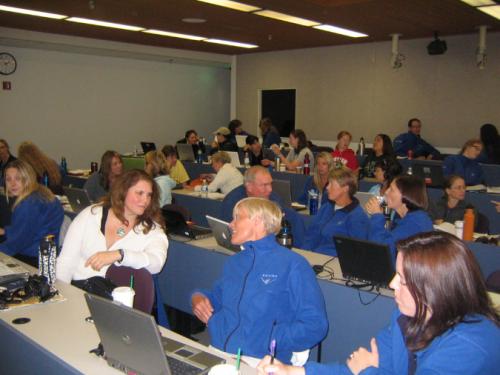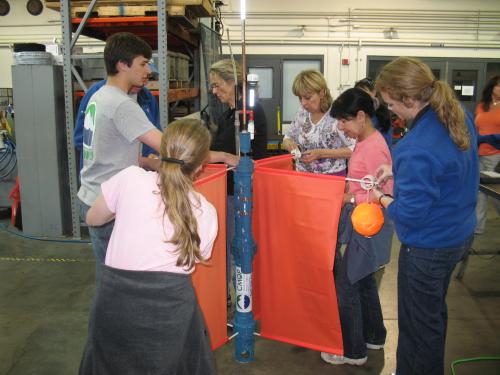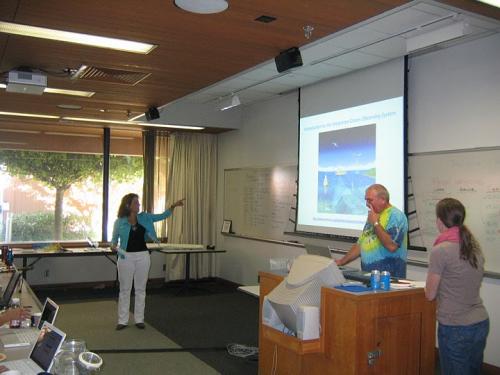You are here
Teachers Get Down to Earth with CMOP Observatory Science
08/09/10 Portland, Ore.
Scientists from the Center for Coastal Margin Observation & Prediction (CMOP) teamed up with teachers from around the country this summer to transform the center's observatory data into curriculum for students.
 EARTH Workshop Teachers
EARTH Workshop Teachers
Teachers gather to spend the week learning about observatory data.
View photos from the workshop.CMOP hosted the Education and Research: Testing Hypotheses (EARTH) 2010 workshop in Beaverton, Oregon from July 11-16, 2010. The EARTH workshop provided teachers with the means to take oceanographic data and develop engaging curricula for their classrooms. EARTH is an education and outreach collaboration between Monterey Bay Aquarium Research Institute (MBARI) and Monterey Bay Aquarium.
George Matsumoto, Ph.D. is the Senior Education and Research Specialist at MBARI and heads up the EARTH program. “The workshop was fabulous and highly successful,” says Matsumoto. “This year’s teachers surpassed previous workshops in terms of quality and quantity of activities dealing with real data.”

Teachers get hands on experience with drifters during a trip to CMOP's field operations in Astoria, Oregon.
View video of teachers building a drifter.Approximately 30 science teachers attended the workshop. They spent the week with CMOP and MBARI scientists learning about ocean observatories and the data they collect.
CMOP modeling research associate Grant Law spoke about how the Science and Technology University Research Network (SATURN) is a tremendous resource for scientists because it brings together so many types of data, at a scale impossible to achieve using traditional ship-based methodologies.
“These technologies allow us to view coastal processes as they develop and usually in real time,” says Law. “All the qualities that make SATURN valuable to science, also make it an invaluable tool for educators, providing a direct link between students and the coastal ocean.”
A unique feature of this year’s workshop was presentations by three CMOP summer high school interns, a first for an EARTH workshop. Monica Reyna, Sierra Reid, and Julia McDowell gave presentations describing themselves and their summer projects working with CMOP data. Their open and candid talks were such a big hit that the teachers invited them to spend the next few days at the workshop.
Karen Wegner, CMOP director of K-12 education, was the co-facilitator for the workshop. She encouraged the students to give presentations and was pleased with the results. “It was great for the teachers to hear from students what works and doesn’t work in the classroom,” Wegner says.
By week’s end, the teachers used the information they learned to create entire lesson plans of coastal margin science activities capitalizing on CMOP's data resources.

Livingston, McCarthy, and Seal present their glider data lesson plan on the last day of the workshop.
View all the lesson plans developed at the workshop.Three teachers teamed up to create a four-part lesson plan entirely around CMOP’s glider data. They included: Carmelina Livingston, St. Andrew’s School of Math and Science in Charleston, SC; Anne McCarthy, Claudia Taylor Johnson High School in San Antonio, TX; and Steve Seal, Eshelman Avenue Elementary School in Los Angeles, CA.
“The data tools CMOP uses to get the information are awesome,” says Livingston. “I want to expose this to my students and have them explore if there is anything similar to it in our area of the country.”
Livingston and her team created a plan that introduced the glider, compared and contrasted information from different missions, provided instructions for glider data exploration, and explored the concepts of scale and slope by plotting and graphing glider data.
It was clear from the teachers’ responses to the workshop that they valued and were intrigued by the data CMOP collects. “CMOP has done an outstanding job with their data in terms of visualizations,” says Matsumoto. “A lot of research groups collect data but not all research groups have been able to express that data in products that teachers can utilize.”
The EARTH 2010 workshop was a success due to scientists sharing their research data with teachers and the teachers who took the data and turned it into classroom activities. The workshop succeeded because both groups worked together for a common goal to expose students to real world data.
“I was thrilled about how much CMOP information was incorporated into the teacher’s activities,” says Wegner. “We are excited the Center’s information is going to be in classrooms and schools around the United States.”
She hopes to adapt the EARTH workshop model on a smaller level for local teachers. That way CMOP can keep the river of data flowing into classrooms around the Northwest.
Written by Jeff Schilling
###
Related Links
» EARTH website
» EARTH Facebook page
» EARTH 2010 lesson plans
» EARTH 2010 photo gallery
» SATURN (CMOP's Science and Technology University Research Network)
» CMOP Observatory Network
» Glider information: data, article, video






